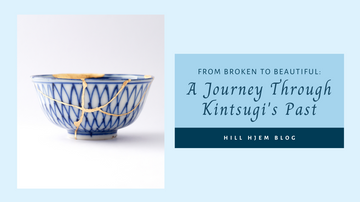From Broken to Beautiful: A Journey Through Kintsugi's Past
by Trishia Mae Cordova on Feb 21, 2024

Ever dropped your favorite plate? Watched in despair as it shattered into a thousand pieces? The sting of imperfection, the pressure to replace, discard, and move on… We've all been there. But what if there was a way to restore it.
Kintsugi, the Japanese art of repairing broken pottery with gold lacquer, is more than a method of mending. It is a philosophy that embraces the beauty of imperfection and finds value in the history of an object. Kintsugi literally translates to "golden joinery," it reflects the way that the cracks are not hidden, but rather highlighted and celebrated.
The exact origins of Kintsugi are unknown, but it is believed to have originated in the 15th century. One popular story tells how a Japanese shogun, Ashikaga Yoshimasa, broke his favorite tea bowl and sent it to China for repairs. When the bowl was returned, it had been repaired with staples, which the shogun found unsightly. He then commissioned Japanese artisans to develop a new method of repair that would be both aesthetically pleasing and functional.
Kintsugi swiftly gained popularity among the Japanese elite, especially during the revered tea ceremonies. The tea bowls, which were considered objects of great beauty and value, could now be repaired in a way that preserved their unique character and history.
Over time, Kintsugi evolved into a symbol of the Japanese philosophy of wabi-sabi, which emphasizes the beauty found in imperfection and impermanence. Kintsugi teaches us that, like objects, people are not perfect. We may break, but these flaws are part of our story, and it's the imperfections that make us truly unique and even more beautiful.
In recent years, Kintsugi has transcended its Japanese roots, captivating people worldwide with its aesthetic appeal and message of resilience. In a world where we are constantly bombarded with images of perfection, Kintsugi serves as a timeless reminder that our flaws and imperfections tell a story. It teaches us to embrace our imperfections and celebrate our unique journeys, rather than striving for an unattainable standard of perfection.
Through Kintsugi, we learn that our brokenness does not define us, but rather, it is a part of our story that is worth preserving and celebrating.
Why You Should Try Kintsugi?
1. It's a creative process
You get to use your imagination and creativity to piece together the broken object and decide how to highlight the repairs with gold. There is no right or wrong way, so you can express yourself freely.
2. It's meditative and relaxing
The process of carefully cleaning, piecing together, and applying the gold can be very calming and therapeutic. It's a great way to de-stress and focus on the present moment.
3. It's a unique way to upcycle
Instead of throwing away a broken piece of pottery, you can give it a new lease on life by repairing it with gold. This is a sustainable way to add beauty and value to your belongings.
4. It's a challenge
Kintsugi requires patience, precision, and a steady hand. It can be challenging to get the pieces to fit together perfectly and apply the gold evenly, but that's also part of the fun.
5. It's a conversation starter
A repaired piece of pottery with gold accents is sure to draw attention and spark conversation. It's a great way to share the story of the object and the art of Kintsugi with others.
6. It's a bonding experience
Kintsugi can be a great activity to do with friends, family, or loved ones. You can work together on a project, share stories, and learn from each other.
Whether you're a seasoned artist or a complete beginner, Kintsugi can be a fun and rewarding experience. So why not give it a try?
Don't miss out on the Kintsugi experience – grab your Repair Kit now!




